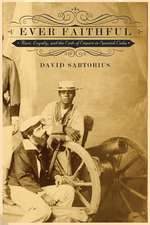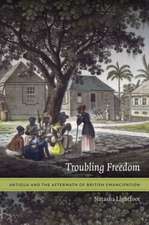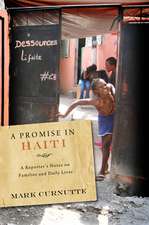Blazing Cane – Sugar Communities, Class, and State Formation in Cuba, 1868–1959: American Encounters/Global Interactions
Autor Gillian Mcgillivrayen Limba Engleză Paperback – 22 noi 2009
Din seria American Encounters/Global Interactions
-
 Preț: 160.91 lei
Preț: 160.91 lei -
 Preț: 239.64 lei
Preț: 239.64 lei -
 Preț: 194.09 lei
Preț: 194.09 lei -
 Preț: 270.04 lei
Preț: 270.04 lei -
 Preț: 230.15 lei
Preț: 230.15 lei -
 Preț: 308.90 lei
Preț: 308.90 lei -
 Preț: 306.22 lei
Preț: 306.22 lei -
 Preț: 311.22 lei
Preț: 311.22 lei -
 Preț: 212.30 lei
Preț: 212.30 lei -
 Preț: 302.19 lei
Preț: 302.19 lei -
 Preț: 266.18 lei
Preț: 266.18 lei -
 Preț: 266.18 lei
Preț: 266.18 lei -
 Preț: 263.29 lei
Preț: 263.29 lei -
 Preț: 262.32 lei
Preț: 262.32 lei -
 Preț: 211.88 lei
Preț: 211.88 lei -
 Preț: 301.59 lei
Preț: 301.59 lei -
 Preț: 306.00 lei
Preț: 306.00 lei -
 Preț: 302.74 lei
Preț: 302.74 lei -
 Preț: 241.03 lei
Preț: 241.03 lei -
 Preț: 303.11 lei
Preț: 303.11 lei -
 Preț: 309.71 lei
Preț: 309.71 lei -
 Preț: 201.81 lei
Preț: 201.81 lei -
 Preț: 213.83 lei
Preț: 213.83 lei -
 Preț: 300.24 lei
Preț: 300.24 lei -
 Preț: 306.38 lei
Preț: 306.38 lei -
 Preț: 313.51 lei
Preț: 313.51 lei -
 Preț: 332.75 lei
Preț: 332.75 lei -
 Preț: 301.59 lei
Preț: 301.59 lei -
 Preț: 241.03 lei
Preț: 241.03 lei -
 Preț: 269.06 lei
Preț: 269.06 lei -
 Preț: 215.19 lei
Preț: 215.19 lei -
 Preț: 305.08 lei
Preț: 305.08 lei -
 Preț: 304.31 lei
Preț: 304.31 lei -
 Preț: 301.00 lei
Preț: 301.00 lei -
 Preț: 238.01 lei
Preț: 238.01 lei -
 Preț: 261.18 lei
Preț: 261.18 lei -
 Preț: 261.18 lei
Preț: 261.18 lei -
 Preț: 299.68 lei
Preț: 299.68 lei -
 Preț: 303.50 lei
Preț: 303.50 lei -
 Preț: 262.52 lei
Preț: 262.52 lei
Preț: 305.46 lei
Nou
Puncte Express: 458
Preț estimativ în valută:
58.45€ • 62.50$ • 48.73£
58.45€ • 62.50$ • 48.73£
Carte tipărită la comandă
Livrare economică 18 aprilie-02 mai
Preluare comenzi: 021 569.72.76
Specificații
ISBN-13: 9780822345428
ISBN-10: 0822345420
Pagini: 416
Ilustrații: 35 photographs, 3 tables, 3 maps, 1 figure
Dimensiuni: 168 x 231 x 25 mm
Greutate: 0.6 kg
Editura: MD – Duke University Press
Seria American Encounters/Global Interactions
Locul publicării:United States
ISBN-10: 0822345420
Pagini: 416
Ilustrații: 35 photographs, 3 tables, 3 maps, 1 figure
Dimensiuni: 168 x 231 x 25 mm
Greutate: 0.6 kg
Editura: MD – Duke University Press
Seria American Encounters/Global Interactions
Locul publicării:United States
Cuprins
Contents; About the Series; Illustrations; Tables; Preface and AcknowledgmentsIntroduction; 1 The Colonial Compact, 15001895; 2 Revolutionary Destruction of the Colonial Compact, 18951898; 3 U.S. Power and Cuban Middlemen, 18981917; 4 The Patrons Compact: Peace, Progress and General Menocal, 18991919; 5 Patrons, Matrons, and Resistance, 18991959; 6 From Patronage to Populism and Back Again, 19191926; 7 Revolutionary Rejection of the Patrons Compact, 19261933; 8 The Populist Compact, 19341959; ConclusionAppendix. Selections from the 1946 Chaparra and Delicias Collective Contract; Notes; Glossary of Foreign Language Terms and Important Concepts; Bibliography; Index
Recenzii
"Blazing Cane is in the finest tradition of Cuban rural history, while at the same time clearing a new interpretative path. Gillian McGillivray analyses evolving class struggles in the countryside through the prism of sugar cane burning, primarily from the late colonial era up to the Cuban Revolution of 1959, and in doing so, challenges aspects of the revolutionary governments interpretation of history. Her work fits nicely into an emerging body of scholarship, published in the last decade, that focuses attention on the pre-revolutionary period and seeks to add nuance andcomplexity to an era that has often been overlooked or fallen prey to simple stereotypes.... The section on the Chaparra sugar mill includes 14 photographs from the mill archives, which are of such high quality that one can almost taste the sugar being processed." Frank Argote-Freyre, European Review of Latin American and Caribbean Studies
"Gillian McGillivray offers a new and original understanding of the history of Cuba from the mid-nineteenth century to Castros Cuban revolution by reading that history from the perspective of two sugar communities. She stresses the agency of workers in sugar communities, who asserted demands and engaged with, as they helped shape, the rhetoric of the state and state formation. Blazing Cane is an important contribution to modern Cuban history, and a compelling case for the impossibility of separating the local from the national and transnational in any study.--William E. French, author of A Peaceful and Working People: Manners, Morals, and Class Formation in Northern Mexico
We know very little about the lives of sugar workers and their interactions with the managerial personnel of the mills in which they worked. Gillian McGillivray goes deep into documentary archives to address this gap in the historiography of Cuba. By examining Cuban society and politics through two sugar communities, she gives us an insightful look at how ordinary people coped with the complex and uncertain circumstances that surrounded them in the Cuban republic.--Alejandro de la Fuente, author of A Nation for All: Race, Inequality, and Politics in Twentieth-Century Cuba
"Gillian McGillivray offers a new and original understanding of the history of Cuba from the mid-nineteenth century to Castros Cuban revolution by reading that history from the perspective of two sugar communities. She stresses the agency of workers in sugar communities, who asserted demands and engaged with, as they helped shape, the rhetoric of the state and state formation. Blazing Cane is an important contribution to modern Cuban history, and a compelling case for the impossibility of separating the local from the national and transnational in any study.--William E. French, author of A Peaceful and Working People: Manners, Morals, and Class Formation in Northern Mexico
We know very little about the lives of sugar workers and their interactions with the managerial personnel of the mills in which they worked. Gillian McGillivray goes deep into documentary archives to address this gap in the historiography of Cuba. By examining Cuban society and politics through two sugar communities, she gives us an insightful look at how ordinary people coped with the complex and uncertain circumstances that surrounded them in the Cuban republic.--Alejandro de la Fuente, author of A Nation for All: Race, Inequality, and Politics in Twentieth-Century Cuba
Textul de pe ultima copertă
"We know very little about the lives of sugar workers and their interactions with the managerial personnel of the mills in which they worked. McGillivray goes deep into documentary archives to address this vital shortcoming of the historiography of Cuba, to look at Cuban society and politics through two sugar communities. Blazing Cane gives an insightful look at how ordinary people coped with the complex and uncertain circumstances that surrounded them in the Cuban republic."--Alejandro de la Fuente, author of "A Nation for All: Race, Inequality, and Politics in Twentieth-Century Cuba"
Notă biografică
Descriere
Discusses the national and transnational implications of local developments in two sugar mill communities in Cuba












